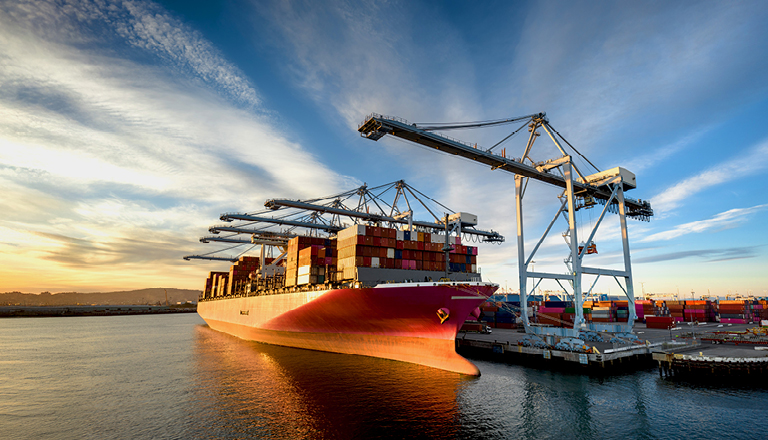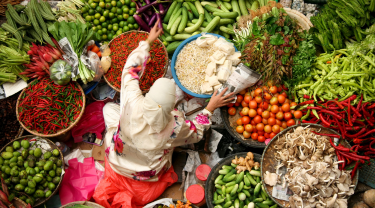For visitors, Malaysia, Singapore, and Australia are vastly different nations, with unique cultures, economies and landscapes. Yet, their shared geography within the Indo-Pacific region ties them together as key players in global trade.
To Canadian exporters, they represent a diverse range of opportunities—from high-tech manufacturing to agricultural exports. Their strategic locations and thriving markets make them attractive destinations for expansion.
- Malaysia’s transformation from an agriculture-based economy to a leading manufacturer of electrical and electronic products highlights its rapid economic progress, with a promising gross domestic product (GDP) growth rate averaging 4.5% over the next five years.
- Singapore shines as a beacon of technological innovation, offering economic strength, political stability and a strategic gateway to Southeast Asia. Changi Airport is one of the busiest global airports serving 163 cities in 49 countries and territories, with short flight durations to Southeast Asia destinations, including Bangkok, Kuala Lumpur, Jakarta and Ho Chi Minh City.
- Australia’s resources and strong connections within the Association of Southeast Asian Nations (ASEAN) make it valuable to leverage regional trade networks.
As partners with Canada in the Comprehensive and Progressive Agreement for Trans-Pacific Partnership (CPTPP), the three countries are important for robust regional integration for Canadian exporters into the Indo-Pacific. Review the agreement to learn more about how it can accelerate your company’s growth and to check out Export Development Canada’s Indo-Pacific market intelligence page.
And as EDC opens its 12th office in Thailand in 2025, as part of our Indo-Pacific strategic focus, Canadian businesses have more support than ever, says Diane Belliveau, EDC’s regional vice-president of East Asia and Oceania.
“People are going back to international markets after the pandemic. Global Affairs trade missions are opening the eyes of Canadian companies. We’re hearing about how happy they are to see us in those markets. It shows the way forward,” she says.
For Canadian businesses seeking to diversify into new markets beyond North America, Malaysia, Singapore and Australia are exciting new horizons.
This interactive tool can help you understand your export and foreign investment risks in 70 markets. Free registration gives you fast access to a wide range of information and resources.

Doing business in Malaysia
Malaysia’s transformation over the past several years has been extraordinary. Transitioning from an agriculture-based economy to a leader in electronics manufacturing and services, it’s now one of the largest economies in ASEAN.
This progress has created a significant social achievement: Malaysia has reduced its poverty rate to just 1.4% (2024), carried by robust private consumption growth and the careful moderation of inflation. It’s on track to reach the World Bank’s high-income nation status between 2028 and 2030.
It’ll be a remarkable achievement, says Nadeem Rizwan, an economist at EDC’s Economic and Political Intelligence Centre (EPIC). But reaching its goals means the country must move even higher up the value chain by driving innovation, fostering a knowledge-based economy and expanding its global competitiveness.
“Malaysia plans to become a leading aerospace hub in Southeast Asia by 2030. Their blueprint emphasizes five key subsectors, including maintenance and repair, manufacturing systems, engineering, design services, education and training,” Rizwan says.
“This move, if successful, will get their economy up to the next level. And if they become an aerospace hub, this brings about opportunities for Canadian exporters with expertise in aerospace,” he says.
The country’s leadership is also tackling growth through its Smart City Framework, an ambitious initiative to improve urban living standards. The plan emphasizes significant investments in digital infrastructure, sustainable urban development and innovative technologies.
The focus on sustainable, smart mobility aligns with global trends, making Malaysia an attractive destination for Canadian tech companies and startups.
- In addition to ASEAN, Malaysia is a member of Asia-Pacific Economic Cooperation (APEC), CPTTP, the Regional Comprehensive Economic Partnership (RCEP) and Commonwealth.
- Malaysia is highly dependent on imports for food security. Canadian agri-food and seafood exports represent C$269.7 million, or around 1% of the country’s total agricultural import basket. Soy milk, canola oil, flower, soybeans, port and other food preparations are part of Canada’s export trade.
- Potash and fertilizers are fundamental to Malaysia’s palm oil industry—Canada exported C$227.7 million in 2024.
You should also check out
With growing risks, Canadian companies face new challenges. EDC’s Global Economic Outlook offers insights to help you make better business decisions.
Opportunities for Canadian exporters in Malaysia
Malaysia pledges to reduce its carbon emissions intensity against GDP by 45% in 2030 and achieve net zero by 2050, through its National Energy Transition Roadmap (NETR). Under the upcoming 13th Malaysia Plan, which is set to be implemented from 2026 to 2030, nuclear energy is also being considered as a potential source of clean energy for the country.
This is a unique opportunity for Canadian cleantech companies, says Xiang Liang Chan, EDC’s chief representative for Singapore and Malaysia.
“Internationally, Canada is ranked No. 2 in terms of the number of representations of top cleantech companies. As well as having 170 established hydrogen and fuel cell technology companies, it’s the second-largest producer of hydroelectricity, a Tier 1 nuclear region, and among Top 10 hydrogen producers. These are enormous, very impactful figures and is a demonstration of Canadian cleantech leadership,” she says.
“Canada has significant potential to leverage its strengths in clean technology and its experience in renewable energy solutions. With countries seeking to decarbonize, Canadian export-ready companies can become a key partner in the global transition to a low-cost, climate resilient economy,” she says.
- Malaysia’s Smart City Framework offers opportunities in innovative technologies, renewable energy and sustainable infrastructure solutions, as well as the construction of rail, road and digital infrastructure such as data centres.
- Canadian expertise in aerospace engineering, training and manufacturing could all take flight under Malaysia’s nascent aerospace industry.
- Canadian exporters can support Malaysia’s food security imports with agricultural products, advanced farming technologies and sustainable practices. Canadian agri-food exports are a key part of the Indo-Pacific trade strategy.
- Canada’s high-quality, nutritious food and beverage products are increasingly in demand with the middle class. Up to 90% of the country’s red meat consumption is foreign-sourced.
- Malaysia’s growing health-care sector has opportunities for the import of medical devices, pharmaceuticals and telemedicine.
Key challenges in trading with Malaysia
Trade with Malaysia can present hurdles such as cultural business practices, language and travel distance. The country’s focus on debt reduction also means public-private partnerships (P3) that minimize risk to the economy are favoured. P3 projects must meet several criteria, including financing guarantees and project longevity targets.
Additional trade challenges for Canadian exporters
- Lack of direct logistical relationships between Canada and Malaysia impacts trade costs. Learn more about strategies to accelerate access to the region through EDC’s podcast, Breaking borders: Unlocking Indo-Pacific markets.
- Strong competition exists from other ASEAN countries, including direct competition from Australia and Japan.
- Regulations for agri-food imports, particularly the distribution of non-halal products, can be challenging. But a growing halal certification industry may open opportunities.
Navigating market entry into Malaysia
Malaysia’s global economic standing and healthy financial sector make it an attractive export market, says Rizwan. “Malaysia has a plan. They attract investment. They invest in human capital. And their plan is coming to fruition,” he says.
- Short-term risk rating: Medium
- Top Canadian exports (2024): Fertilizers, aluminum, cereals, oilseeds, electrical machinery and parts
- Canadian exports total value (2024): $1.3 billion
- International trade agreements with Canada: CPTPP
- Population: 35.6 million (2024)

Doing business in Singapore
For a small city state of six million people, Singapore packs a heavy punch in the world. Despite its compact physical footprint, Singapore leads in technology, manufacturing and cleantech, making it a desirable place for startups.
“Because it’s a small nation with limited resources, Singapore understands the necessity to innovate and remain competitive globally,” says Xiang Liang Chan, EDC’s chief representative for Singapore and Malaysia in Global Business Development.
To set the pace of innovation, Singapore’s 2025 budget includes a $1-billion investment in research and development infrastructure, says Susanna Campagna, principal country analyst for Asia within EPIC.
“Singapore is a leader in innovation, which it views as a key driver of sustainable growth, supporting society and the livelihoods of Singaporeans, and keeping Singapore competitive as a regional hub for innovation, technology and trade,” she says.
- Singapore’s biggest assets are its educated, highly skilled workforce. The government invests in a micro-learning fund, so Singaporeans can upgrade skills.
- The nation also boasts high per-capita income levels and a GDP growth forecast around 3% for 2025 and the next five years.
- Singapore’s pro-business stance and role as a key financial and multinational trade hub ensures it consistently ranks amongst the top global economies for competitiveness.
- Singapore has the world’s largest publicly owned port in the world, which is instrumental in connecting more than 600 ports and 123 countries.
Opportunities for Canadian exporters in Singapore
Pro-trade, politically stable and economically robust, Singapore is a prime destination for exporters worldwide. For Canadians, CPTPP embeds a number of advantages for fintech, artificial intelligence (AI), clean energy and advanced manufacturing sectors.
- The World Intellectual Property Organization’s 2024 Global Innovation Index (GII) ranks Singapore in the Top 5 most innovative countries in the world. Key export opportunities include AI, automation and integrated systems tech.
- A 96.9% internet penetration rate and early adoption of new technology making Singapore one of the most connected countries globally.
- Singapore leads in AI innovation and has an AI adoption rate of 53%, placing it amongst the top nations worldwide. Interest in medical AI technology focused on descriptive and predictive analytics, chatbots and imaging analysis offers trade prospects.
- Given its highly urbanized state, Singapore’s buildings account for more than 20% of its carbon emissions. Decarbonizing existing buildings and greening new builds are opportunities in Singapore’s climate change and mitigation strategy.
- Singapore is funding clean energy innovation with a $5-billion fund. Aiming for zero emissions by 2050, the country is focused on solar, regional power grids, low-carbon alternatives and natural gas.
- Nuclear energy is another focus in Singapore’s 2025 budget that can align with Canada’s expertise as a Tier 1 nuclear management country with 17 nuclear facilities.
You should also check out
Explore high-potential markets and strategies to grow internationally while managing risks.
Key challenges in export trade for Canadian businesses
Despite what Singapore offers, Canadian exporters will find ready, regional competition from RCEP countries. RCEP is the world’s largest trading bloc covering 30% of the world GDP, so inter-trade between member countries can be seen as a priority.
- With a small population, Singapore has limited consumer-focused opportunities compared with business-to-business (B2B) trade.
- With external trade as percent of GDP at more than 300%, Singapore is vulnerable to changes in the external trading environment. Slower growth with a key partner, like China, could lead to lower import demand and impact Singapore’s growth outlook. Can Singapore also has strict regulations on imports of certain products such as food and medical devices.
- Amid global trade tensions, Singapore must walk a fine line between the U.S., China and its largest trading partners in Southeast Asia.
- Southeast Asia is a diverse region that defies monolithic business thinking. For success, exporters should consider establishing regional offices supported by local partners. EDC’s Business Connections Program and Canada’s Trade Commissioner Service (TCS) can help create connections.
- For strategies to address these challenges, check out EDC’s online resources.
Navigating market entry into Singapore
With 28 free trade and 65 economic agreements, a reputation for transparency and a tax framework that minimizes tax barriers for international businesses, Singapore is an attractive market for exporters.
- Short-term risk rating: Low
- Top Canadian exports (2023): Energy products, metals ores and minerals, machinery and equipment, consumer goods, forestry and building materials, agri-foods and seafood
- Canadian exports total value (2023): $1.7 billion
- International trade agreements with Canada: CPTPP
- Population: 6.04 million

Doing business in Australia
It’s been called “the lucky country,” the “Great Southern Land” and the “Sunburnt Country” in novels, songs and poems, but Canadian exporters could also call Australia a competitive, yet comfortable place to do business.
Isolated by oceans, Australia has robust international connections, particularly with Japan, China and India, as well as other ASEAN countries. It stands out culturally and geographically from the rest, but when it comes to trade, its position as a member of CPTPP means it’s also part of a massive economic bloc, accounting for 13.5% of global GDP.
There are few barriers for entry to the Australian market, aside from distance and transportation costs. In addition to a history of trade dating back to 1895 when Canada sent the first trade commissioner to Sydney, Canada and Australia share common language, legal and corporate structures, as well as parliamentary systems. Both countries also enjoy reputations for being open, socially equitable and economically stable.
But those similarities also pose issues for exporters, notes Diane Belliveau, EDC’s regional vice-president of East Asia and Oceania.
She says that Australia has similar resources to Canada, in terms of farming, food production, mining, research and development, fisheries and a cleantech industry.
“It’s a well-established market in Australia. So, if your export product is that good and a game-changer, it’s probably going to be a game-changer in Australia, as well,” she says.
Australia is also highly competitive, both internally and within the Indo-Pacific. Canadian businesses going to Australia “really need to be better than the competition,” she says. “If I have a company that comes here with software for the mining sector, I have to ask, ‘Is your software better than all the companies here?’”
- With CPTPP, Global Affairs reports 10% increased total merchandise trade within three years between Canada and new partners such as Australia, Japan, New Zealand, Singapore and Vietnam.
- In 2023, merchandise trade between Canada and Australia totalled $6.4 billion. In services, bilateral trade tallied to around $4 billion, with Canadian exports accounting for $2.7 billion.
- The International Monetary Fund (IMF) predicts that Australia’s growth will continue to outpace other advanced economies in the next five years.
- Canada and Australia collaborate in several areas of trade and governance, including Asia-Pacific Economic Cooperation (APEC), the Commonwealth, Food and Agriculture Organization (FAO), the G20, Inclusive Trade Action Group (ITAG) and many others.
Opportunities for Canadian exporters in Australia
Australia can be a land of opportunity for Canadian businesses offering Next Gen, or unique products in digital infrastructure, cleantech, renewable resources and agri-food. The country’s robust economy, bolstered by its location in the Indo-Pacific, makes it a unique, stable and diversified market.
- The Australian government’s decarbonization plan focuses on clean fuel retrofit solutions, cleantech energy and process modifications in the mining, cement and heavy industries.
- Canada’s TCS identified Australia’s focus on transitioning to a low-carbon economy as a trade opportunity. In 2023, renewable energy (solar, wind and battery) accounted for 39.4% of the country’s total energy generation. Within this sector, there’s demand for long-duration storage solutions.
- Australia has a highly evolved agri-food sector yet, some Canadian companies, like Saputo, are firmly established. Australia imports around $22.8 billion of food and beverage products annually, with opportunities existing for unique or niche products in processed foods, functional food, frozen foods, pet food and seafood.
- The agricultural sector is also seeing growth in autonomous vehicle adoption, controlled environment farming, harvesting technology and digital or remote monitoring tech.
- Australia’s tech sector has grown by 80% since 2020, driven by federal investment in digital infrastructure. Canadian tech firms could do business in telecom and critical infrastructure, network management, transportation development projects and utility management, particularly in the area of climate impacts.
- Canadian direct investment in Australia has steadily increased in the past several years to $58.3 billion in 2023.
You should also check out
Explore how to strengthen supply chains, control rising costs and stay on track during uncertain times.
Key challenges for Canadians trading with Australia
Like Canada, Australia’s prosperity is built on natural resources, trade and a competitive business mindset. As such, Canadian exporters should offer exceptional or unique products and services that set them apart for innovation, scope of use or profitability.
- Staffing in Australia, which has an unemployment rate of 3.9% (2025), can be expensive and challenging. Minimum wage is $24.10/hour and total job vacancies hover around 344,000.
- Distance to market adds complexity and cost, making local partnerships, representatives, or distributors a good strategy.
- Shipping within Australia, like Canada, can be a costly logistical challenge, compounded by the extreme environment.
Navigating market entry into Australia
Successful ventures in Australia start with solid market research, an environmental scan of competitors and a unique value proposition or product. From there, leveraging Canadian expertise and cultural similarities can give exporters an advantage. EDC’s article, Edging out the competition in global markets, has key insights to support exporters.
- Short-term risk rating: Low medium
- Top Canadian exports (2020): Machinery, agricultural products, aircraft and aircraft parts, pharmaceuticals, minerals and metals, wood and paper products
- Canadian exports total value (2023): $3.1 billion
- International trade agreements with Canada: CPTPP
- Population: 26.8 million
EDC is part of the Government of Canada’s trade ecosystem of experts available to help you save time, learn more about your target markets and identify the capital you need to grow. Led by the Trade Commissioner Service (TCS), this network of solution-oriented departments and Crown corporations can solve export problems and offer new perspectives, so exporters can confidently expand and succeed, at home and abroad.
As part of our Indo-Pacific strategy, EDC is committed to helping Canadian companies diversify into new markets and succeed in this dynamic region. This includes in-country representation to support new ventures, financial solutions and trade insights. EDC also offers:
- A full suite of credit insurance products to lower your risk for doing business abroad
- Help with getting access to working capital
- Expertise to enable you to learn more about international markets
- Connections to international companies in need of your products and services
Learn more about how EDC’s financial and knowledge solutions can help you understand the opportunities in your target market and make exporting less risky. To contact an EDC export advisor, visit our Export Help Hub and sign up for MyEDC account.
Interested in growing your business in the Indo-Pacific region?
Connect with EDC and watch your business flourish on the international stage.
Answer a few questions about your company to learn more about how EDC can help to fuel your expansion in the Indo-Pacific.








